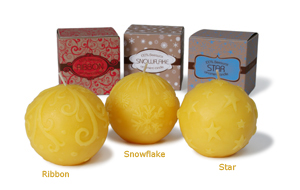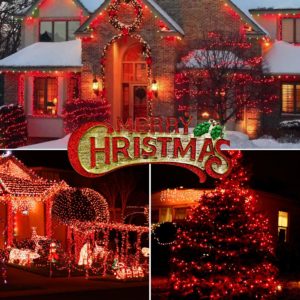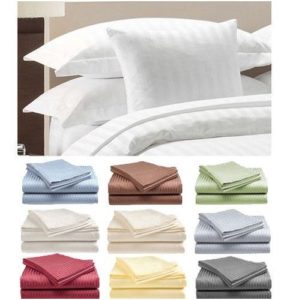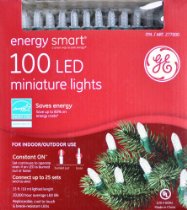 December is such a cold, dark month here in the mid-Atlantic region of the U.S., I think Christmas was invented just to give us an excuse to put bright, cheery lights everywhere.
December is such a cold, dark month here in the mid-Atlantic region of the U.S., I think Christmas was invented just to give us an excuse to put bright, cheery lights everywhere.
At my house, we do! We outline the outside windows of our house in little white twinklers that beautifully frame the Christmas tree inside that’s been lit with multi-colored strands. We don’t have a central fireplace, so we light candles in the main windows, on the tables and on the counters, creating a flickering glow from all corners of the living and dining room. In my best Martha Stewart imitation, I also string garlands, lights and ribbons all the way up the staircase for a fairytale effect. Most nights, after dinner we turn off our regular end table lamps and quietly enjoy the peaceful beauty these subtle sparks create.
For years, of course, we used standard (energy-wasting) incandescents for all of these lights, along with typical paraffin candles. But over the last few years, we’ve begun transitioning to LED lights, and the only candles I buy now are made from beeswax.
Why LEDs?
Initially, the LED lights reflected more my commitment to the environment than my love for the quality of their light. LEDs, or light-emitting diodes, are environmentally preferable because they’re so incredibly efficient: while a string of 300 conventional mini Christmas lights costs about $13.12 to operate, 300 LEDs will cost only around $1.25 to power up. The downside? The first white LEDS on the market threw such a harsh, cold light, it completely defeated the purpose of using those lights to create the sense of warmth.
But the technology has evolved considerably (replacing my pain at being an “early adopter” with the satisfaction of knowing that my demand increased a better supply!). LEDs now come in a glow that’s actually called “warm,” along with pretty green, red and blue bulbs. They’re also available in larger bulbs as well as the tiny, twinkly ones. For those who celebrate Hanukkah, you can get strings of only blue bulbs as well.
Where? LED holiday lights have become so mainstream you can find them at most local hardware stores, at big box outlets like Wal Mart and Target, and online at Forever Bright and Christmas Lights, etc. But be prepared: they do cost more upfront than incandescents. You’ll make the money back over time in electricity savings. And an equally big bonus: LEDs last longer than the fragile incandescents, so you’ll neither have to replace the lights every year, nor spend hours trying to figure out which tiny incandescent bulb in your mini strand is broken. That’s a huge plus in this busy mom’s book.
Why beeswax candles?
Candles made from beeswax have a lot going for them: their natural golden honey color, their sweet but subtle smell, the clean way they burn. They don’t drip, either, so you can use them in tapers, votives, or as molded stand alones on a table or window sill.
They can be hard to come by in the mall, but you’ll find them aplenty online.
Big Dipper Wax Works – Among the many choices are 3″ beeswax ornaments in the shape of a Star, Snowflake or Ribbon that each will burn for over 40 hours; elegant tapers whose wicks are 100% cotton and contain no lead or metal, and larger “pedestals” in a variety of colors.
Beeswax Candle Company – Beautiful holiday candles shaped into holly spirals, pinecones, trees, pillars and columns. Plus beautiful accessories, including candle holders and tapers.
Candlebee Farm – Additive-free and solar powered processes bring you dripless tapers, plain pillars and votive styles; you can also choose solid poured or rolled honeycomb candles.
Beeswax Company – Natural candles molded into creative shapes, like beehives, balls and cubes, votives and tealights.
Candles made from soy can be a good alternative, if you don’t mind the heavy fragrances many of them emit. You can find them here.
For more environmentally friendly holiday traditions, visit this month’s Green Moms Carnival, hosted by Michelle McKenzie over at Green Phone Booth.














8 thoughts on “Energy-Efficient Lights and Eco-Friendly Holiday Candles”
I added a string of LED lights to the front of my house this year. I think I prefer the light quality. The LEDs have a brighter more glow-y quality that the small incandescents don’t have.
I LOVE the smell of beeswax candles. They are the only kind I will burn these days. I get them from a local vendor at the farmers market.
I’m so excited for the sales to switch over to LED’s for next year. My hubby did buy one small strand of the snowflake LED’s from the dollar store and they are really lovely. I like the brightness of the lights and the fact that they save money and energy makes me love them all the more.
Hi Diane,
I was going to buy some of these cute, eco-friendly LED lights, until I read the California Proposition 65 warning on the back of the box– the brand I found in-store has LEAD in the plastic coating on the wire. Just thought I’d mention it since I was very shocked to see lead in Christmas lights.
Tammy/Diane,
It’s likely your old incandescent string lights contain lead also, it’s what makes the PVC coating pliable and fire-proof, apparently a requirement from the UL. It’s just more obvious now that the CA Prop 65 label is plastered all over them now. If you find lights w/o the label, it’s likely the lead is still there, it’s just that those lights aren’t sold in CA. There isn’t any more lead in new lights as there are in old lights and the amount is below applicable federal guidelines.
great post diane – I love that we have these choices!
Thanks for sharing your holiday tradition. You’ve inspired me to put out some candles!
Good news about the new Christmas lights. It’s encouraging to know the manufactures are keeping energy saving in mind. Now we have to get the rest of the world to join them.
Comments are closed.